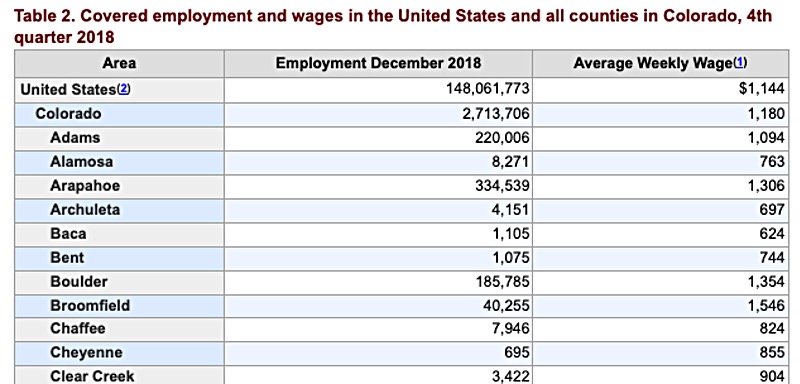The Commission was aware of the pressures for growth and development that currently exist in this area and has chosen to give the Council broad flexibility and power to properly deal with issues related to growth and development. The Charter requires the adoption and updating of a Comprehensive Plan to ensure that growth and development issues are given careful consideration.
– from the Pagosa Springs Home Rule Charter, approved by Town voters in 2003.
We ended Part Three on Friday with a photograph of a massive parking lot.

We don’t have any parking lots this large in Pagosa Springs — not even close — although the parking lot at our local Walmart store might conjure up similar feelings, if viewed from above during Black Friday.
The Town Planning Commission has been discussing the problems posed by parking in recent weeks, as part of a new direction the commission seems to be taking. For many years now, the Town Planning Commission has been less of a “planning commission” and more of a “rubber stamping commission.” Development projects were brought before the volunteer commission already vetted and analyzed by Town staff — vetting which the Town staff is indeed paid to do — and the volunteers on the Planning Commission made decisions based mainly on the staff analysis. Each analysis, in turn, has been based mainly upon the Town’s Land Use and Development Code (LUDC), as interpreted by the staff.
The LUDC is part of the Town’s collection of laws — so many laws — contained in the 407-page Municipal Code. You can read the Municipal Code here.
But the Town Planning Commission has done fairly little, in recent years, in terms of actual “planning.” Mostly, the Planning Commission and the Town staff — like the rest of us — has been riding a pro-development chairlift to heaven. A seemingly unstoppable chairlift. And the LUDC and the Town Comprehensive Plan have formed the steel towers on which the chairlift is carried, in terms of parking and community expansion and building design and a myriad other societal aspects. (I currently serve on the Town Planning Commission, but this editorial series expresses my personal opinions, and does not necessarily reflect the opinions of the commission as a whole.)
Over the past few months, however, the volunteer Planning Commission has been taking direction from a couple of paragraphs found in the LUDC, that define the commission’s authority.
A. Establishment, duties, and authority.
The Planning Commission is established pursuant to the authority of Sections 8.1 and 8.2 of the [Town Home Rule] Charter. The Planning Commission shall have all powers granted and shall perform all the duties imposed by the Charter and statutes of the State of Colorado. The Planning Commission shall have the review and decision-making authorities listed in Table 2.2-1, and in addition shall have the following duties and responsibilities:
1. Develop and recommend to the Town Council new policies, ordinances, administrative procedures, and other means that allow expansion to be accomplished in a coordinated and efficient manner;
2. Conduct studies and recommend to the Town Council, any other new plans, goals, and objectives relating to growth, development, and redevelopment of the Town…
It appears, from the text shown above, that the Town Planning Commission is tasked with developing policies and ordinances — laws — that “allow expansion to be accomplished in a coordinated and efficient manner.”
We take note of the word, “expansion.” Back in 2003, the Pagosa Springs Home Rule Charter Commission was well aware that Archuleta County had one of the highest growth rates — measured in percentages — of any county in Colorado. The population of the county had doubled between 1970 and 1990, and doubled again between 1990 and 2000. (It’s been fairly static since about 2005.) The Charter Commission phrased the problem this way in the Home Rule Charter “Prefatory Synopsis.”
The Charter is intended to safeguard the well-being of all inhabitants of the Town, to maintain a community that sustains livability and places the highest value on the good of the entire community, and to set forth a framework for the future growth and development of the Town while protecting both its fundamental identity and its future economic vitality.
Whatever the Charter’s intent might have been in 2003, the results have been mixed, if we’re talking about “all inhabitants of the Town”. The framework may have been set for future growth and development, and there are certainly signs, in 2020, of “economic vitality.” But many families have been kicked off the economic chairlift, or never had a chance to get on.
If you visit Wikipedia, you can find a list of Colorado counties ranked by the overall economic vitality of those communities, as measured by “per capita” income.
Pitkin County, for example — which includes the mountain resort town of Aspen — is ranked Number One. Its 8,200 residents enjoy a per-capita income of around $64,400 per year (2010 Census data.)
At the bottom of the list, we find Bent County. 1,800 residents who have a per-capita income of about $16,500. One quarter the income of Pitkin County.
Smack dab in the middle of the list we find Archuleta County — ranked 31 out of 64 Colorado counties. sandwiched between Chaffee County (home to Salida and Buena Vista) and Weld County (home to Longmont and Greeley). This list (using 2010 Census data) gives the per-capita income of Archuleta County as about $25,400. Not a bad number, if you consider this includes every man, woman and child in the community.

The list gives our “Median Family Income” as about $65,500 per year.
But visit the US Bureau of Labor Statistics, and you find a rather different story. Our average weekly wage in Archuleta County is about $697 a week. Out of the 64 counties in Colorado, 53 have higher average weekly wages than Archuleta County. Only 10 have lower wages. Even Bent County — the county with the lowest per-capita income in the state – pays a higher aaverage wage.

Our wages here are not even 60% of the average wage in the state as a whole.
When measured simply by “income” — which includes our many retirees — we’re comfortably in the middle of the pack, here in Colorado. When we look at workers’ wages, we’re very near the bottom.
How about that big idea — planning for “all the inhabitants of the Town”? Is something screwed up?
Is it something we can fix?

